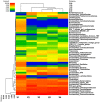The microbial community in the feces of the white rhinoceros (Ceratotherium simum) as determined by barcoded pyrosequencing analysis - PubMed (original) (raw)
The microbial community in the feces of the white rhinoceros (Ceratotherium simum) as determined by barcoded pyrosequencing analysis
Gaorui Bian et al. PLoS One. 2013.
Abstract
As a non-ruminant herbivore, the white rhinoceros has the ability to utilize fibrous plant matter through microbial fermentation in the hindgut. So far, there has been no report using molecular techniques to study the gut microbiota of the white rhinoceros. We used barcoded pyrosequencing to characterize 105,651 sequences of 16S rRNA genes obtained from fecal samples from five white rhinoceroses. Results showed that Firmicutes and Bacteroidetes were the predominant phyla in the samples, which were comprised largely of unclassified bacteria. The microbiota of one animal treated with drug therapy differed from those in other healthy animals, and was dominated by Aerococcus -related bacteria. The core microbiota in the healthy rhinoceros were dominated by phyla Firmicutes and Bacteroidetes, represented by the Ruminococcaceae, Lachnospiraceae, Rikenellaceae and Prevotellaceae families. The present work provides a phylogenetic framework for understanding the complex microbial community of the rhinoceros; however, further studies are required to link the distinctive microbiota with their digestive role in the hindgut of the white rhinoceros.
Conflict of interest statement
Competing Interests: The authors have declared that no competing interests exist.
Figures
Figure 1. Rarefaction curves.
Rarefaction curves comparing the number of reads with the number of phylotypes found in the DNA in the feces of five rhinoceroses.
Figure 2. Fecal bacterial community at the phylum level.
Relative abundance of bacterial groups (phylum level) in the feces of five white rhinoceroses.
Figure 3. Fecal bacterial community at the family level.
Relative abundance of bacterial groups (family level) in the feces of five white rhimoceroses.
Figure 4. Fecal bacterial community at the genus level.
Relative abundance of bacterial groups (genus level) in the feces of five white rhinoceroses.
Figure 5. Bacterial distribution among the five samples.
Double dendrogram showing the bacterial distribution among the fecal samples of five rhinoceroses. The bacterial phylogenetic tree was calculated using the neighbor-joining method, and the relationship among samples was determined using Bray distance and the complete clustering method. Total 50 genera with the abundance higher than 0.1% within total bacteria were sorted for the analysis. The heatmap plot depicts the relative percentage of each bacterial genus (variables clustering on the Y-axis) within each sample (X-axis clustering). The relative values for the bacterial genus are depicted by color intensity in the legend indicated at the top of the figure. Clusters based on the distance of the five samples along the X-axis and the bacterial genera along the Y-axis are indicated at the top and bottom of the figure, respectively.
Similar articles
- Diversity of methanogens in the hindgut of captive white rhinoceroses, Ceratotherium simum.
Luo YH, Wright AD, Li YL, Li H, Yang QH, Luo LJ, Yang MX. Luo YH, et al. BMC Microbiol. 2013 Sep 12;13:207. doi: 10.1186/1471-2180-13-207. BMC Microbiol. 2013. PMID: 24228793 Free PMC article. - High-Throughput Sequencing Reveals a Dynamic Bacterial Linkage between the Captive White Rhinoceros and Its Environment.
Zhong X, Zhao J, Chen Y, Liao Y, Qin T, Zhang D, Lai X, Yang C, Wang Y, Zhang X, Yang M. Zhong X, et al. Microbiol Spectr. 2023 Aug 17;11(4):e0092123. doi: 10.1128/spectrum.00921-23. Epub 2023 Jul 6. Microbiol Spectr. 2023. PMID: 37409954 Free PMC article. - Gut Microbiota and Phytoestrogen-Associated Infertility in Southern White Rhinoceros.
Williams CL, Ybarra AR, Meredith AN, Durrant BS, Tubbs CW. Williams CL, et al. mBio. 2019 Apr 9;10(2):e00311-19. doi: 10.1128/mBio.00311-19. mBio. 2019. PMID: 30967461 Free PMC article. - GUT MICROBIOME DIVERSITY OF THREE RHINOCEROS SPECIES IN EUROPEAN ZOOS.
van der Meijs RM, van Leeuwen W, Prins C, Wittink F, Pirovano W, Duijsings D, van den Bogert B, Bruins-van Sonsbeek LGR. van der Meijs RM, et al. J Zoo Wildl Med. 2024 Jun;55(2):301-312. doi: 10.1638/2023-0046. J Zoo Wildl Med. 2024. PMID: 38875187
Cited by
- Characterization of the cellulolytic bacteria communities along the gastrointestinal tract of Chinese Mongolian sheep by using PCR-DGGE and real-time PCR analysis.
Zeng Y, Zeng D, Zhang Y, Ni X, Tang Y, Zhu H, Wang H, Yin Z, Pan K, Jing B. Zeng Y, et al. World J Microbiol Biotechnol. 2015 Jul;31(7):1103-13. doi: 10.1007/s11274-015-1860-z. Epub 2015 May 1. World J Microbiol Biotechnol. 2015. PMID: 25931374 - Conserved core microbiota in managed and free-ranging Loxodonta africana elephants.
Thorel M, Obregon D, Mulot B, Maitre A, Mateos-Hernandez L, Moalic PY, Wu-Chuang A, Cabezas-Cruz A, Leclerc A. Thorel M, et al. Front Microbiol. 2023 Oct 4;14:1247719. doi: 10.3389/fmicb.2023.1247719. eCollection 2023. Front Microbiol. 2023. PMID: 37860133 Free PMC article. - Analysis and comparison of the wolf microbiome under different environmental factors using three different data of Next Generation Sequencing.
Wu X, Zhang H, Chen J, Shang S, Yan J, Chen Y, Tang X, Zhang H. Wu X, et al. Sci Rep. 2017 Sep 12;7(1):11332. doi: 10.1038/s41598-017-11770-4. Sci Rep. 2017. PMID: 28900198 Free PMC article. - Tapirus bairdii-Associated Fecal Microbiome from a Critical Conservation Area: Calakmul, México.
Yanez-Montalvo A, Gaona O, Águila B, Arias-Domínguez N, Falcón LI, Pérez-Flores J. Yanez-Montalvo A, et al. Curr Microbiol. 2021 Jul;78(7):2648-2659. doi: 10.1007/s00284-021-02531-8. Epub 2021 May 15. Curr Microbiol. 2021. PMID: 33990869
References
- McNaughton SJ, Georgiadis NJ (1986) Ecology of African grazing and browsing mammals. Ann Rev Ecol Syst 17: 39–65.
- Clemens ET, Maloiy GMO (1982) The digestive physiology of three East African herbivores: the elephant, rhinoceros and hippopotamus. J Zool 198: 141–156.
- Kienzle E, Schramel P, Dierenfeld ES, Flach EJ, Behlert O, et al. (2006) Macromineral absorption in the black rhinoceros (Diceros bicornis) compared with the domestic horse. J Nutr 136: 2017S–2020S. - PubMed
Publication types
MeSH terms
Substances
LinkOut - more resources
Full Text Sources
Other Literature Sources
Medical
Research Materials




